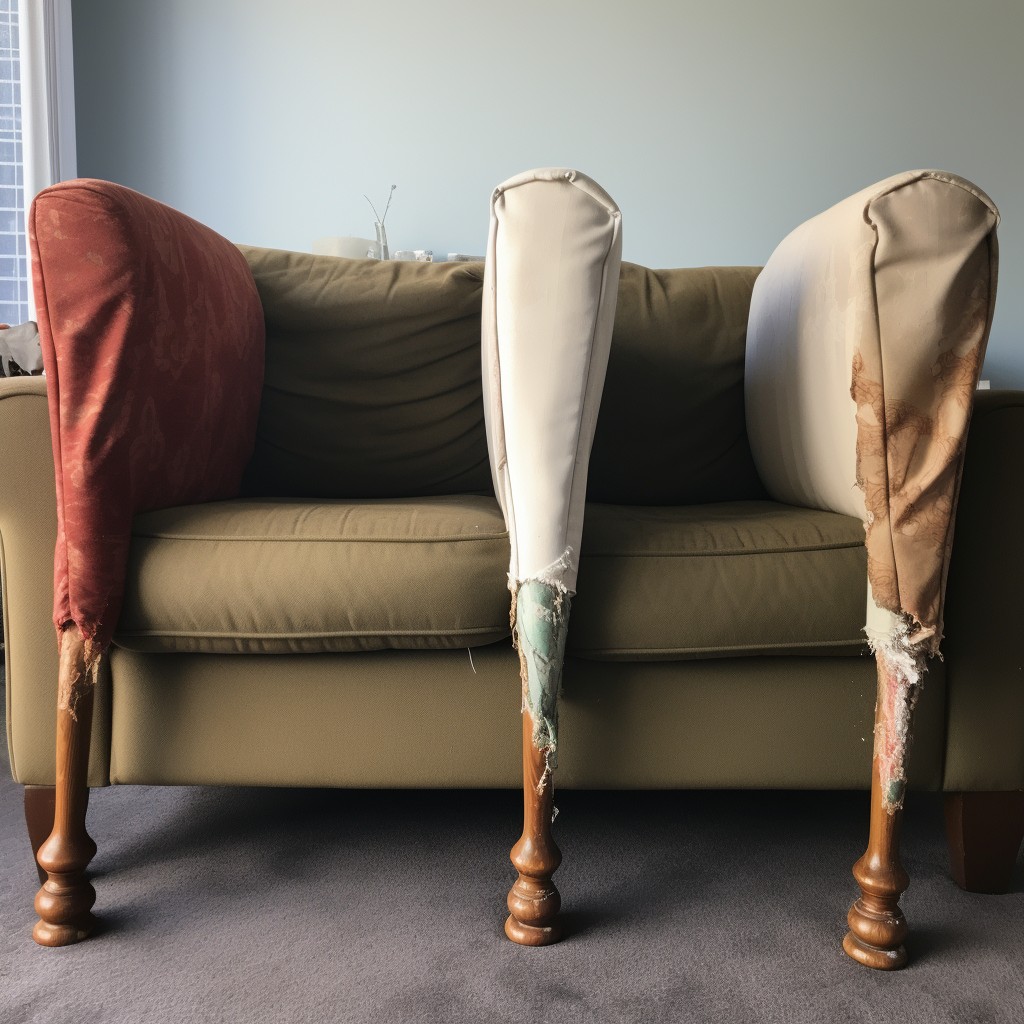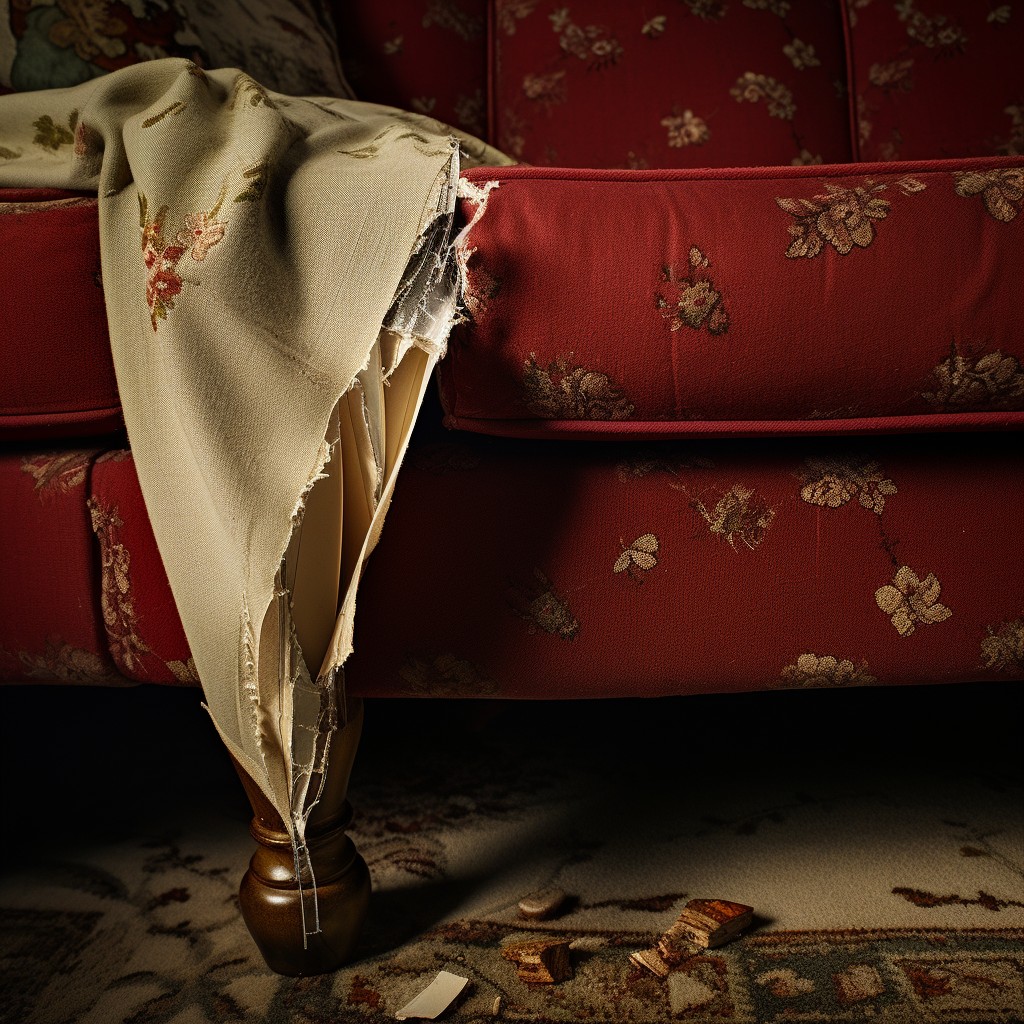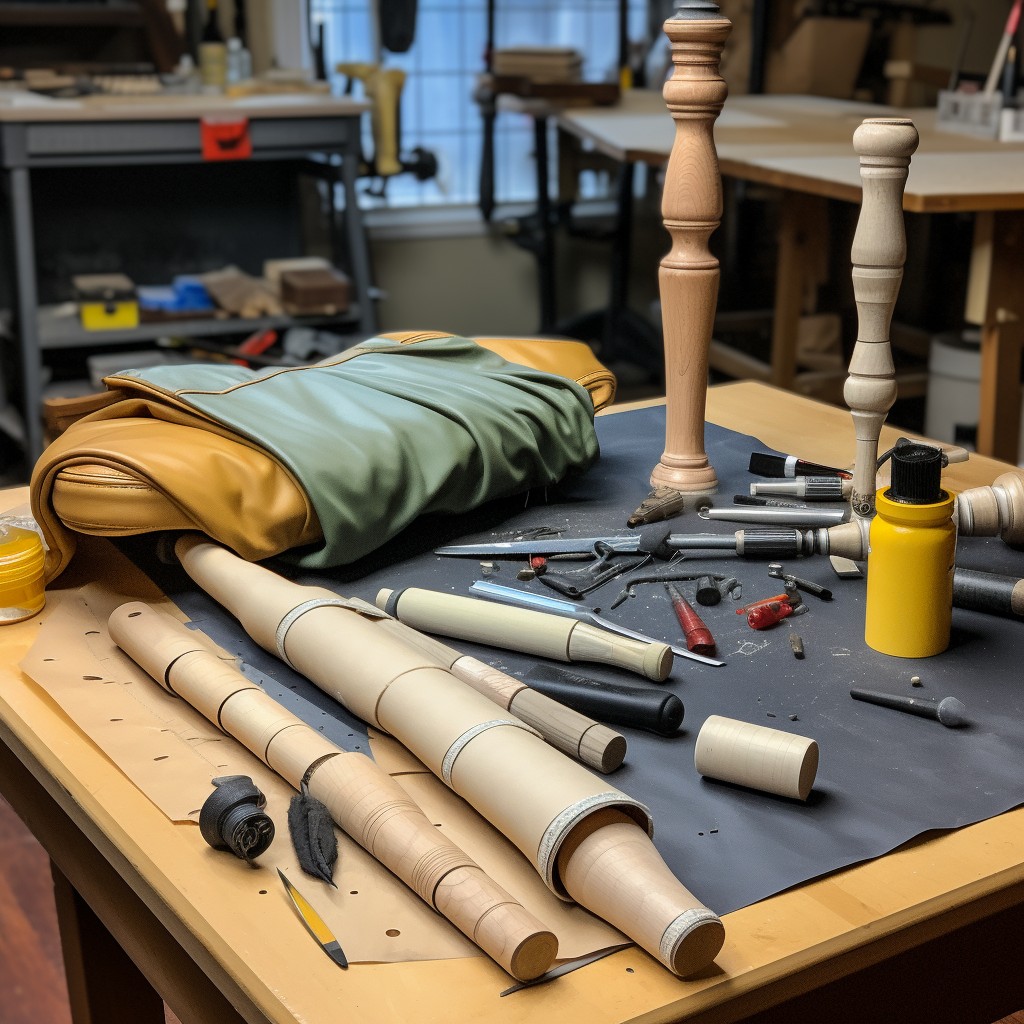Last updated on
Discover the simple steps to fix your couch legs and restore stability and comfort to your favorite piece of furniture.
Have you ever sat down on your couch and noticed that it wobbles or leans to one side? Or perhaps you have accidentally broken a leg while moving furniture around. Whatever the case may be, dealing with couch legs can be frustrating and time-consuming.
But fear not! In this article, we will guide you through the process of fixing couch legs like a pro. Whether you’re a DIY enthusiast or just looking to save some money on repairs, we’ve got you covered with easy-to-follow steps and helpful tips.
So grab your tools and let’s get started!
Table of Contents
Identifying Couch Leg Issues

Before you can fix your couch legs, it’s important to identify the issue at hand. There are several common problems that can affect couch legs, including wobbling or unevenness, loose attachments or screws, broken leg brackets or joints and missing legs.
Identifying the specific problem will help you determine what tools and materials you’ll need for repairs.
One way to identify issues with your couch legs is by simply sitting on it and observing any movement or instability. If your sofa rocks back-and-forth when pressure is applied from one side of the seat cushion to another then there may be an issue with a leg attachment point.
Another way to check for issues is by inspecting each individual leg closely. Look out for cracks in wooden frames as well as rusted metal parts if applicable; these could indicate damage that needs repair before further use.
Identifying Damaged Couch Legs

Before you can start repairing or replacing any damaged legs, you need to know what’s wrong with them. The most common issues with couch legs include wobbling, leaning, cracking or breaking off completely.
To identify damaged couch legs, start by inspecting each leg carefully for signs of wear and tear. Look for cracks or splits in the wood or metal frame that could be causing instability.
Check if any screws are loose and whether they need tightening.
If your sofa has been moved around a lot recently, it may have caused some damage to its structure without you realizing it yet. Sit on different parts of the sofa and see if there is any noticeable movement when pressure is applied.
Another way to check for damage is by placing a level on top of each leg individually while applying weight evenly across all four corners of the seat cushion area; this will help determine which leg(s) are unevenly balanced compared with others.
Required Tools and Materials

Depending on the type of repair needed, you may need some or all of these items:
- Screwdriver (flathead or Phillips)
- Pliers
- Hammer
- Wood glue
- Screws (various sizes)
- Drill with drill bits
- Measuring tape
- Sandpaper
It’s a good idea to assess the damage before gathering supplies so that you can be sure to have everything on hand. If any parts need replacing, such as broken leg attachments or missing legs altogether, make sure to purchase those ahead of time as well.
Once you have everything ready and at your disposal, it will be much easier and quicker for you when repairing your couch legs.
Gathering Necessary Tools

This will save you time and frustration later on. The good news is that most of these items can be found in your toolbox or local hardware store.
Firstly, make sure you have a set of screwdrivers with different sizes and types of heads such as Phillips head or flathead screwdrivers. You may also need pliers for removing stubborn screws or nails.
Next, grab a measuring tape to ensure accurate measurements when replacing broken legs or installing leg extenders.
You’ll also need wood glue if any joints are loose or damaged. A drill with various bits will come in handy for drilling new holes if needed.
Consider purchasing furniture leg brackets if the original ones are missing or damaged beyond repair.
Assessing Leg Damage
This will help you determine whether a simple repair or a complete replacement is necessary. Start by examining each leg carefully and checking for any visible signs of damage such as cracks, splits, or missing pieces.
If the legs are wobbly or uneven but appear to be intact, they may just need tightening or adjusting. However, if there are significant structural issues like broken attachments or weak joints that cannot be repaired with glue and clamps alone then replacing them might be necessary.
It’s also essential to check if all four legs have equal length because even minor differences can cause instability in your furniture piece leading to discomfort while sitting on it.
Removing Couch Legs
This may seem like a daunting task, but it’s actually quite simple if you follow these steps:
1. Clear the area around the couch: Move any nearby furniture or objects out of the way so that you have enough space to work.
2. Flip the couch over: Carefully turn your sofa upside down and place it on a soft surface such as carpeting or blankets.
3. Locate leg attachments: Look for screws, bolts, brackets, or other fasteners that attach each leg to the frame of your sofa.
4. Remove fasteners with tools: Use pliers and screwdrivers (or an electric drill) to loosen and remove all fasteners holding each leg in place.
- Gently pull off legs from frame: Once all attachments are removed from one side of your sofa’s base structure gently wiggle off each corresponding leg by pulling straight down until they come free.
- Repeat process for remaining legs: Repeat this process for every single one of its four corners until all four legs are detached from their respective attachment points on both sides.
Tightening Loose Legs
This can be a frustrating experience, but fortunately, it’s an easy fix. Tightening loose legs is one of the simplest ways to restore stability and comfort to your couch.
To tighten loose legs on your couch, you’ll need a few basic tools such as pliers and screwdrivers. First off, flip over the sofa so that you have access to its underside where the leg attachments are located.
Use pliers or a wrench if necessary to hold onto any nuts while turning screws with a screwdriver.
Next up is tightening all bolts and screws that attach each leg bracket securely in place against their respective corners of frame rails underneath (or directly into) seat cushions themselves – depending upon design specifics).
Securing Loose Couch Legs
Loose legs can cause the couch to wobble or even collapse, which can be dangerous and damaging. To secure loose couch legs, start by flipping the furniture over so that you have access to the underside of the frame.
Next, use a wrench or pliers to tighten any screws or bolts that may have come loose over time. If there are no visible screws or bolts holding the leg in place, look for metal brackets connecting each leg to the frame of your sofa.
Use a screwdriver and wood glue (if necessary) on these brackets before tightening any screws with a wrench until they’re snugly in place again.
Reattaching Broken Legs
The first step is to remove the damaged leg from the couch. Once removed, assess the damage and determine if it can be repaired or if a replacement leg is needed.
To reattach a broken couch leg, use wood glue to secure any loose joints or cracks in the wood. Apply pressure with clamps until dry and then reinforce with screws for added stability.
If your broken couch leg cannot be repaired using this method, consider purchasing a replacement that matches your existing legs’ size and style. Attach it using screws or brackets as necessary.
Remember always to follow safety precautions when working with tools such as drills and saws during repairs.
Repairing Broken Leg Attachments
In some cases, you can repair the attachment with a few simple steps. First, remove the damaged bracket from the couch leg and clean any debris or dirt from both pieces.
Then apply a strong adhesive such as epoxy glue to both surfaces and press them together firmly for several minutes until they bond securely.
Once dry, reattach the repaired bracket back onto your couch using screws or bolts that are appropriate for its size and weight capacity. Be sure to tighten them securely so that they do not loosen over time.
It’s important to note that repairing broken leg attachments should only be attempted if you have experience working with adhesives and tools like screwdrivers or wrenches. If you’re unsure about how to proceed or feel uncomfortable doing it yourself, seek professional help instead.
Fixing Wobbly Legs
Not only is it uncomfortable to sit on, but it can also be dangerous if the couch tips over. Fortunately, fixing wobbly legs is a relatively simple process that you can do yourself with just a few tools and materials.
The first step in fixing wobbly legs is to identify which leg or legs are causing the problem. Once you have identified the culprit(s), remove them from the couch using your screwdriver or wrench.
Next, inspect each leg for damage or wear and tear that may be contributing to its instability. If any of the legs appear damaged beyond repair, consider replacing them entirely.
To fix a loose joint between two pieces of wood on one of your couch’s feet (or anywhere else), try injecting some wood glue into any gaps between those pieces before reattaching everything together again with screws/nails/clamps as needed – this will help strengthen weak joints so they don’t move around as much when weight shifts around while sitting down/standing up/etcetera!
Replacing Missing Legs
First, identify the type of leg your couch has and measure its dimensions to ensure that the replacement legs will fit properly. You can find replacement legs at most furniture stores or online retailers.
Once you have your new legs, remove any remaining pieces of the old leg from underneath your couch. Then attach the new leg by screwing it into place using a drill or screwdriver.
It’s important to note that if one of your original legs was damaged beyond repair and needs replacing but all other three are still intact then replace only one so as not to create an uneven surface for sitting on which could cause discomfort over time.
Replacing missing couch legs is an easy fix that can make a big difference in both appearance and stability.
Replacing Damaged Legs
This is a relatively simple process that can be done in just a few steps.
First, identify the type of leg attachment on your couch. Some legs screw directly into the frame while others attach with brackets or bolts.
Once you have determined this, remove the damaged leg by unscrewing it from its attachment point.
Next, measure the height and width of your existing legs to ensure that you purchase replacements that match in size and style. You can find replacement legs at most furniture stores or online retailers.
Once you have obtained new legs, simply screw them into place using either their original attachments or any included hardware provided with the new set of replacement feet.
Repairing Scratches and Dents
First, clean the affected area with a damp cloth and let it dry completely. Then, use wood filler to fill in any deep scratches or dents.
Apply the filler using a putty knife and smooth out any excess material.
Once the wood filler has dried completely (usually overnight), sand down the repaired area until it is smooth and level with the rest of the leg surface. Use fine-grit sandpaper for best results.
Apply stain or paint to match your couch legs’ original color if necessary. Allow time for drying before reattaching them back onto your furniture piece.
Strengthening Weak Legs
Strengthening weak legs is an essential step in ensuring the longevity of your furniture. One way to do this is by using wood glue or epoxy resin to reinforce any cracks or splits in the leg itself.
Simply apply a small amount of glue or resin into the crack and clamp it together until dry.
Another option for strengthening weak legs is by adding metal brackets around joints where two pieces meet. These brackets can be found at most hardware stores and come in various sizes depending on your needs.
It’s important to note that while these methods can help strengthen weakened areas, they may not be suitable for severely damaged couch legs. In such cases, replacing the leg entirely may be necessary.
Reinforcing Weak Joints
Reinforcing these joints can help prevent further damage and prolong the life of your furniture. To reinforce weak joints, start by removing the leg from the couch and inspecting it for any cracks or damage.
If there is no visible damage, apply wood glue to both sides of the joint and clamp them together tightly until dry.
For added strength, consider using metal brackets or corner braces on either side of the joint before reattaching the leg to your couch. These brackets will provide extra support and stability where needed most.
Remember that reinforcing weak joints is not a one-time fix; regular maintenance is necessary to keep them strong over time. Check for loose screws or bolts periodically and tighten as needed.
Adjusting Uneven Legs
This can cause discomfort and even lead to further damage if left unaddressed. Fortunately, adjusting uneven legs is a relatively simple fix.
To start, identify which leg(s) are causing the problem by using a level tool or placing something flat on top of each leg to see which ones are lower than the others. Once you have identified the problematic leg(s), use shims (small pieces of wood or plastic) under them until they reach an equal height with their counterparts.
Alternatively, some couches may have adjustable feet that can be turned clockwise or counterclockwise to adjust their height individually. If this is the case for your furniture piece, simply turn these feet until all four corners sit evenly on your floor surface.
Adjusting uneven legs not only improves comfort but also helps prevent further damage from occurring over time due to weight distribution issues caused by an unstable base.
Installing Leg Extenders
Leg extenders are available in various sizes and materials such as wood or metal. They attach to the bottom of your existing couch legs and provide additional height without compromising stability.
To install leg extenders, first remove the existing legs from your couch by following our earlier instructions. Then measure the length of each removed leg and purchase corresponding size extender brackets.
Attach one bracket onto each end of every new extender using screws provided with them. Next, screw these brackets into place on top of where old ones were attached before removing them from their positions on furniture’s underside surface (make sure they’re level).
Finally reattach all four extended legs back onto their respective corners underneath sofa frame securely using screws again provided with new hardware kit for this purpose only!
Proper Bracket Measurements
This step is crucial in ensuring that your repaired or replaced legs are secure and stable.
To begin, measure the distance between each leg attachment point on your couch frame. Make sure to measure both horizontally and vertically as some frames may be angled or curved.
Once you have these measurements, use them to determine where exactly on the new brackets you will need to drill holes for attaching them securely.
It’s important not only to get accurate measurements but also ensure that all of your brackets are level with one another so that they can support weight evenly across all four corners of a piece of furniture like a sofa or loveseat.
Caring for Couch Legs
Regular maintenance can prevent future damage and save you from having to make repairs down the line.
To care for your couch legs, start by cleaning them regularly with a soft cloth or sponge. Avoid using harsh chemicals that could damage the finish or weaken the wood.
If you have pets at home, consider covering your couch legs with protective sleeves or caps. This will help prevent scratches and bite marks from damaging the wood.
Be mindful of how much weight is placed on each leg when sitting on your couch. Overloading one leg can cause it to become weak over time and eventually break off completely.
By following these simple tips for caring for your couch legs, you’ll be able to enjoy a sturdy and comfortable piece of furniture for years to come!
FAQ
How are couch legs attached?
Couch legs are attached either through direct attachment by screwing them directly into the sofa’s bottom or through plate attachment by securing them to a metal or wood plate, which is then attached to the sofa’s bottom.
Can I replace the legs on my sofa?
Yes, you can replace the legs on your sofa to completely change its look and style, often at a low cost.
What are the different types of couch leg materials and which one is best for my sofa?
Types of couch leg materials include wood, metal, and plastic, and the best choice for your sofa depends on your preferences, budget, and aesthetic.
When should I consider repairing couch legs instead of replacing them?
Consider repairing couch legs instead of replacing them when the damage is minimal and can be restored easily, ensuring structural stability.
What tools and techniques are essential for fixing or replacing couch legs?
Essential tools and techniques for fixing or replacing couch legs include a screwdriver, wrench, wood glue, and proper measurements for a secure and accurate installation.





